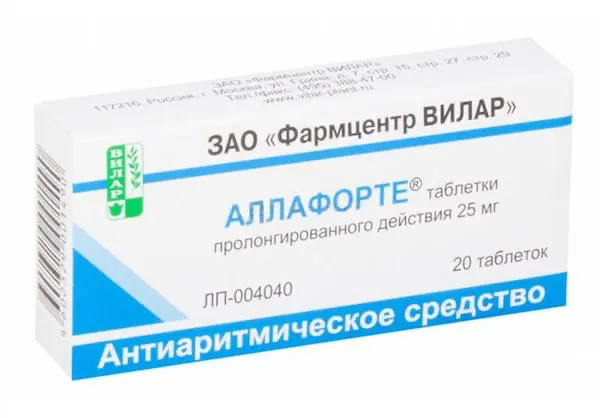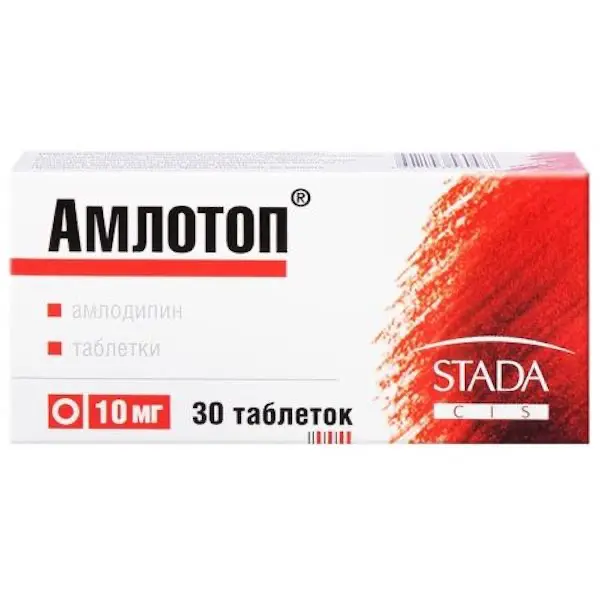Description
Allaforte Pharmacological properties
Active substance of the drug is a bromine hydrogenated salt of lappaconitin alkaloid with accompanying alkaloids, derived from white bean hogweed herb or rhizomes and roots of white bean hogweed – Aconitum leucostomum Worosch, or from rhizomes with roots of northern borage (wolfsbane) – Aconitum septentrionale Koelle (A. excelsum Reichenb.), of the buttercup family – Ranunculaceae, or from technical alkaloids sum of the buttercup family.
Pharmacodynamics
Antiarrhythmic drug of class IC.
Blocks “fast” sodium channels of cardiomyocyte membranes. It causes delay in atrioventricular (AV) and intraventricular conduction, inhibits conduction through additional pathways in Wolff-Parkinson-White syndrome, shortens effective and functional refractory periods of atria, AV node, Gis bundle and Purkinje fibers. It does not affect the QT interval duration, AV node conduction in vanterograde direction, heart rate (HR) and blood pressure (BP), myocardial contractility (in the initial absence of heart failure phenomena). It does not inhibit sinus node automatism, has no negative inotropic effect, has no antihypertensive and m-cholinolytic effects.
It has moderate antispasmodic, coronary dilator, local anesthetic and sedative effect.
When administered orally, the effect occurs after 40-60 minutes, remains at the achieved level for 4-5 hours and then gradually decreases. In general, the effect of the drug after a single oral administration lasts for at least 12 hours.
Indications
Ventricular and ventricular extrasystoles, paroxysmal forms of atrial fibrillation and flutter, paroxysmal supraventricular tachycardia, including in Wolf-Parkinson-White syndrome, paroxysmal ventricular tachycardia (in the absence of myocardial organic changes).
Contraindications
Hypersensitivity to the drug components, sinoatrial block, AV block of II and III degree (without artificial pacemaker), cardiogenic shock, right bundle branch block combined with left bundle branch block, severe arterial hypotension (systolic BP less than 90 mm Hg), chronic heart failure III-IV functional class according to NYHA classification, significant left ventricular myocardial hypertrophy (? 1.4 cm), presence of postinfarction cardiosclerosis, acute coronary syndrome, Brugada syndrome, arrhythmogenic cardiomyopathy (dysplasia) of the right ventricle, severe liver and/or renal dysfunction, age under 18 years, lactose intolerance, lactase deficiency or glucose-galactose malabsorption, prolonged or shortened QT interval syndrome, heart defects, arrhythmogenic effect of any antiarrhythmic drug in anamnesis, pregnancy, breast-feeding, alcohol abuse, AV block of degree I with PQ interval prolongation more than 200 ms, dilated cardiomyopathy, restrictive cardiomyopathy, myocarditis, absence of antiarrhythmic effect during treatment with Allapinin® in anamnesis.
Caution:
Use with caution in intraventricular conduction disorders, blockade of one of the branches of Glis bundle, sinus node weakness syndrome, bradycardia, severe peripheral circulation disorders, closed angle glaucoma, benign prostatic hypertrophy, electrolyte balance disorders (hypokalemia, hyperkalemia, hypomagnesemia), in simultaneous use of other antiarrhythmic agents, in ischemic heart disease.
Pregnancy and lactation:
Animal studies have shown that lappaconitine hydrobromide at doses of 1-5 mg/kg does not have teratogenic and embryotoxic effects. It is not recommended to use the drug during pregnancy due to the lack of controlled studies.
It is possible to use the drug only for vital indications, if the estimated benefit to the mother exceeds the potential risk of fetal/infant side effects.
There are no data on excretion of lappaconitine hydrobromide into the breast milk. The use of the drug is not recommended during breast-feeding.
If the use of Allaforte® during lactation is necessary, breastfeeding should be stopped.
How to use and dosages
- Reception of the drug should begin under the supervision of a doctor.
Inside, after a meal, swallowing the entire tablet with a small amount of water at room temperature. - Tablets are strictly prohibited to break, crush or chew!
The dose of Allaforte® is adjusted individually. Treatment should begin with tablets of 25 mg every 8 hours. In the absence or insufficiency of therapeutic effect the dose should be increased – tablets 25 mg every 6 hours or 50 mg tablets every 12 hours. To judge about the therapeutic effect of the drug at its first use or at increasing of the dose it is necessary not earlier than after 2-3 days of regular use of the drug. - To prevent undesirable effects of the drug on cardiac conduction system, its use and dose increase should be monitored by ECG. It is reasonable to record ECG 1-2 hours after taking another single dose of the drug.
If PQ interval lengthening to 300 ms or development of atrial-ventricular block of higher degree, the dose should be reduced, stopping the treatment temporarily, if necessary.
Lengthening of QRS complex by up to 25% of initial value is safe, but QRS duration should not exceed 140 ms. Lengthening of QRS complex over 50% of the initial one or more than 160 ms is unacceptable! - Maximum daily dose is 100 mg (25 mg 4 times per day or 50 mg 2 times per day). It is not recommended to take the drug in a dose more than 100 mg per day due to the lack of controlled clinical trials.
- Transfer of patients taking Allapinin® to treatment with Allafort® is carried out by simple substitution, starting from the next intake of one drug for another with the same doses and intervals between doses.
- The duration of treatment and dosing regimen correction (dose increase) is determined by the physician.





